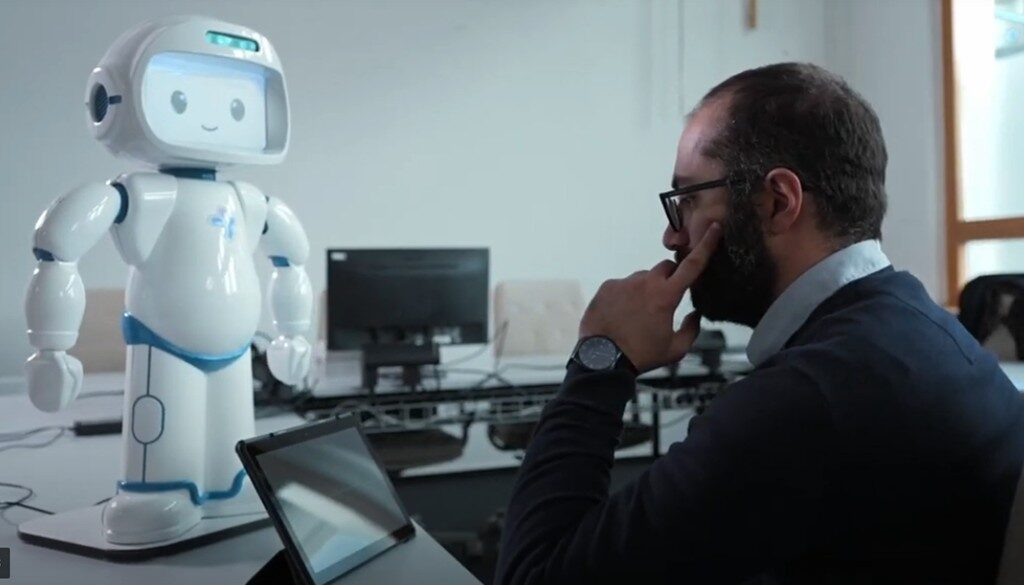
Can a learning robot help children with Autism Spectrum Disorder (ASD) in their therapy journey? A research team from three universities in North Rhine-Westphalia has been investigating this question. Their work at Hochschule Bonn-Rhein-Sieg (H-BRS) has led to the development of a social robot prototype designed to engage children in interactive learning tasks. Alongside this, they have also created an online platform to provide families with reliable, up-to-date information about autism.
Meet QTrobot: A Learning Assistant for Children with ASD
At the heart of this research is QTrobot (or “Cutie”), a 60-centimeter-tall social robot that helps children learn through interactive exercises. In a demonstration, Dr. Alex Mitrevski, an expert in learning robots at H-BRS, interacts with QT using a tablet-based learning game. The robot instructs, “Tap on the cow,” as images of various animals appear on the screen. When Dr. Mitrevski selects the correct answer, QT responds with positive reinforcement, saying, “Good, you get a star for that,” while its animated face moves expressively.
How Can QTrobot Support Autism Therapy?
QTrobot is specifically designed for social interactions between humans and machines and is currently being tested in various projects worldwide. In this study, researchers explored how it could be integrated into learning psychology support programs for children with ASD.
Beyond delivering structured learning activities, QT is equipped with a built-in camera that monitors whether a child remains engaged. If the child looks away or becomes distracted, QT responds by using motivational prompts in a child-friendly manner to regain their attention. To enhance this feature, researchers at Rheinische Fachhochschule Köln have developed an AI-based tool that helps the robot recognize nonverbal cues such as head position, gaze direction, and facial expressions.
The Importance of Early Intervention
According to autism specialists, early support is crucial for children with ASD. The research team, led by Professor Hanns Rüdiger Röttgers, a psychiatrist and psychotherapist from Münster University of Applied Sciences, emphasizes that intervention programs should ideally begin before the age of four to maximize developmental potential.
Through the MIA model project (Münster Intensive Program for children with ASD), the researchers have been working with preschool and primary school children since 2010. Their findings suggest that practical, everyday exercises are particularly effective in therapy. That’s why QTrobot doesn’t just teach vocabulary—it can also guide children through daily routines like washing hands or brushing teeth, reinforcing essential self-care habits.
Robots in Therapy: A Helpful Companion, Not a Replacement
While robots will never replace therapists, they can serve as valuable learning assistants. According to Röttgers, developing new skills—especially language and communication—can be time-consuming and require repetitive practice. Given the shortage of trained specialists, robots like QT could help fill the gap by providing consistent, patient, and engaging support.
However, further research is needed before QT can be widely used in real-world therapy. The project team is focusing on refining how the robot interprets children’s reactions to ensure optimal interaction. Once these refinements are complete, QTrobot could work independently with children, following a gradual familiarization process.
“In our tests, the children reacted very positively to QT,” says Dr. Mitrevski. “This has shown us that robots can play a meaningful role in autism therapy in the future.”
Support for Families: A Multilingual Online Platform
In addition to developing QTrobot, the MigrAVE project has created an informational online platform at www.migrave.de. This resource provides learning materials, practical tips, and support for families of children with ASD. Designed with inclusivity in mind, both the website and the learning robot have been developed in multiple languages to better support families from diverse backgrounds. As research on AI and social robots advances, tools like QTrobot may become powerful allies in supporting children with ASD—helping them develop essential skills and fostering independence in a fun and engaging way.
Reference:
https://www.h-brs.de/en/kum/press_release/h-brs-research-team-develops-learning-robots-autistic-children